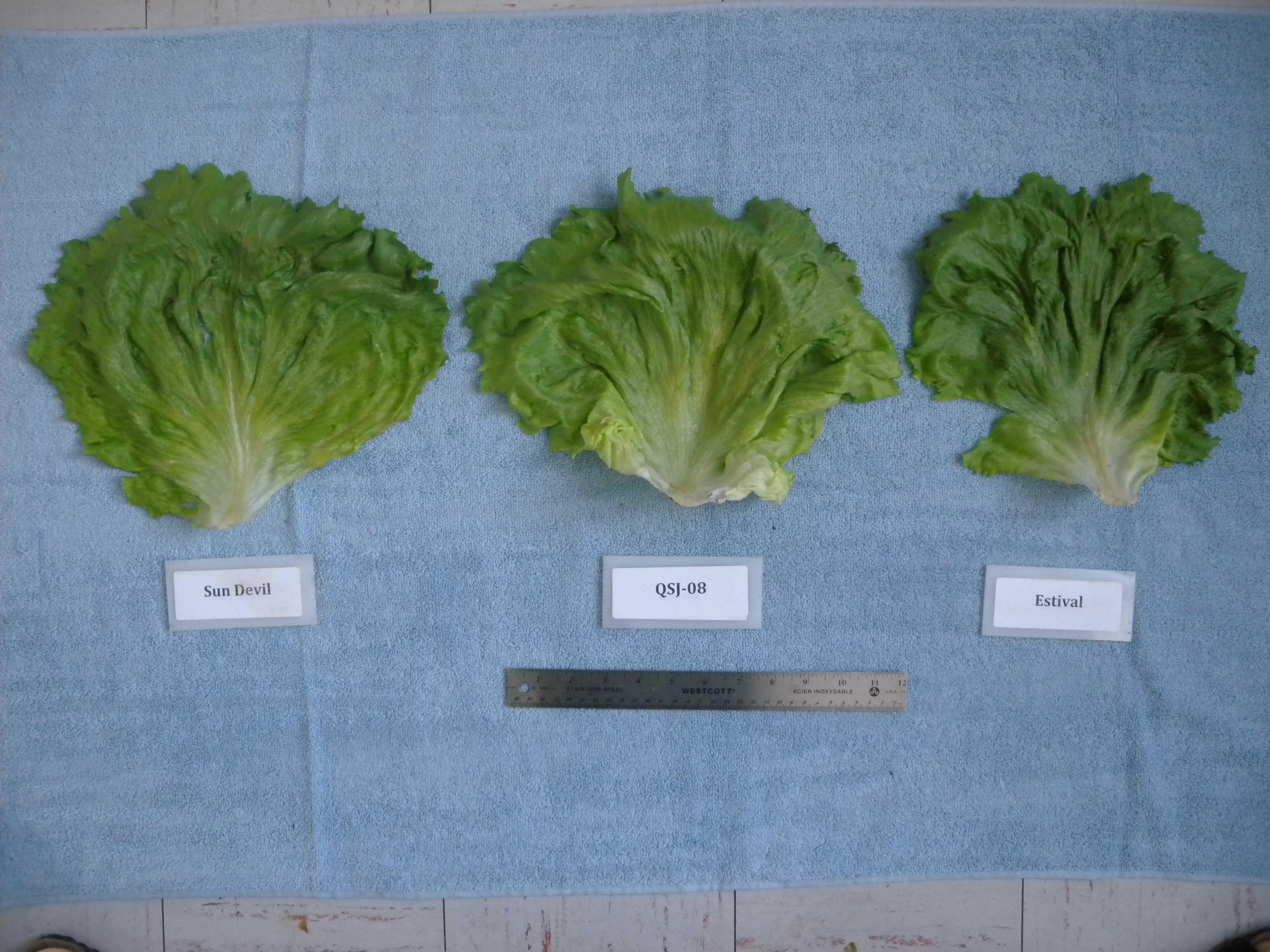AAC Canicula
| Denomination: | 'AAC Canicula' |
|---|---|
| Previously Proposed Denomination: | 'Canicula' |
| Botanical Name: | Lactuca sativa |
| Applicant/Holder: |
Agriculture & Agri-Food Canada, Saint-Jean-sur-Richelieu Horticulture Research & Development Centre 430, boulevard Gouin, P.O. Box 457 Saint-Jean-sur-Richelieu, Quebec J3B 3E6 Canada |
| Breeder: |
Sylvie Jenni, Agriculture & Agri-Food Canada, Saint-Jean-sur-Richelieu, Quebec |
| Agent in Canada: |
Agriculture & Agri-Food Canada Office of Intellectual Property and Commercialization c/o Shannon Whyte 107 Science Place Saskatoon, Saskatchewan S7N 0X2 Canada Tel: (204) 999-9887 |
| Application Date: | 2010-05-05 |
| Application Number: | 10-6984 |
| Grant of Rights Date: | 2017-05-11 |
| Certificate Number: | 5486 |
| Grant of Rights Termination Date: | 2037-05-11 |
Variety Description
Varieties used for comparison: 'Estival' and 'Sun Devil'
Summary: At maturity, the outer leaves of ' AAC Canicula' are medium green whereas those of 'Estival' are dark green. The outer leaf of 'AAC Canicula' has a transverse narrow elliptic shape whereas that of 'Estival' is circular and that of 'Sun Devil' has a transverse broad elliptic shape. At harvest maturity, 'AAC Canicula' has a shorter stem than 'Sun Devil'. The seeds of 'AAC Canicula' are black whereas those for 'Sun Devil' are white.
Description:
PLANT: closed head type, absent or very weak axillary sprouting, bolting under long day conditions begins late, mid-season to late harvest maturity
SEEDLING: no anthocyanin colouration, no division of leaf blade at 10 to 12 leaf stage
HEAD: closed head formation with medium degree of overlapping of upper part of leaves, dense, circular shape in longitudinal section
LEAF: medium to thick, semi-erect to horizontal attitude at harvest maturity, transverse narrow elliptic shape, obtuse tip, greyish hue on green outer leaves, medium green on outer side of outer leaves, no anthocyanin colouration, weak to moderate glossiness on upper side, weak degree of blistering, medium sized blisters, weak degree of undulation of margin, weak to medium density of shallow sinuate incisions of margin on apical part, flabellate (fan shaped) venation
SEED: black seed coat
PHYSIOLOGICAL REACTION: leaves of the head are resistant to moderately resistant to rib discolouration when cultivated during hot summer growing conditions (i.e. a heat-related physiological disorder).
Origin & Breeding History: 'AAC Canicula' (experimental designations 'X300-M-186-1083.3' and 'QSJ-08') originated from a cross made in October of 1998 between the variety 'Valleygreen', as the female parent, and the variety 'Ithaca', as the male parent, in the greenhouses of the Agriculture & Agri-Food Canada Horticultural Research and Development Centre in Saint-Jean-sur-Richelieu, Québec. F1 seeds were planted in the greenhouses in December of 1998 and F2 seeds were collected and bulk massed in June of 1999. From 2000 to 2002, successive generations were grown and harvested at the Sainte-Clotilde experimental station and at a muck soil farm in Napierville, Québec. The selections from each were based on good 'Vanguard' character combined with size, a tendancy for a pointed base, low ribbiness, colour, short core, weight, excellent leaf configuration and lack of symptoms of rib discolouration. In 2003, F5 seedlings designated as 'X300-M-186-1083.3' were transplanted and evaluated. From 2004 to 2006, single plant selections continued on the F6 to F8 plants. During 2006, F8 seeds were planted in single plant progeny rows in the San Joaquin Valley in California for seed evaluation and multiplication. Ten single plants were selected and F9 seeds were collected from individual plants, the remainder of which were bulk massed after harvest in September of that year. Trials were assessed in replicated plots from 2007 to 2009. In December of 2009, 'X300-M-186-1083.3-252-42-888' was considered a new variety and became known as 'QSJ-08'.
Tests & Trials: The comparative trials for 'AAC Canicula' were conducted at the Ferme JPL Guérin, in Sherrington, Québec during the summers of 2012 and 2015. Both the candidate and reference varieties were sown in the greenhouse and later transplanted into fields of organic soil. Each variety was planted in four randomly planted plots. The plots were composed of two rows spaced 35.5 cm and planted in mounds that were 14.6 metres long and 0.91 metres wide. Each plot contained 80 plants resulting in a total of 320 plants per variety. The plants were grown under normal conditions for cultivation with long days (photoperiod between 15 and 16 hours per day). The lettuce was harvested and evaluated at the time of optimal maturity during the last 2 weeks of July. All measured characteristics were based on measurements of 12 plants per replicate for a total of 48 plants. Mean differences were significant at the 5% probability level based on LSD values.
Comparison tables for 'AAC Canicula' with reference varieties 'Estival' and 'Sun Devil'
Length of stem (from base of first external leaf forming head to apical bud) (mm)
| 'AAC Canicula' | 'Estival' | 'Sun Devil' | |
|---|---|---|---|
| mean (2012) (LSD=3.2) | 54.5 | 57.6 | 59.8 |
| std. deviation (2012) | 8.95 | 7.21 | 7.28 |
| mean (2015) (LSD=2.6) | 53.0 | 56.6 | 59.8 |
| std. deviation (2015) | 5.97 | 5.84 | 8.03 |
Plants showing symptoms of rib discoloration (%)
| 'AAC Canicula' | 'Estival' | 'Sun Devil' | |
|---|---|---|---|
| mean (2012) (LSD=18.6) | 15.7 | 25.4 | 36.9 |
| std. deviation (2012) | 13.0 | 11.1 | 5.8 |
| mean (2015) (LSD=23.0) | 24.2 | 35.0 | 60.8 |
| std. deviation (2015) | 9.2 | 10.0 | 13.4 |
Click on image for larger view

Lettuce: 'AAC Canicula' (centre) with reference varieties 'Sun Devil' (left) and 'Estival' (right)
- Date modified: